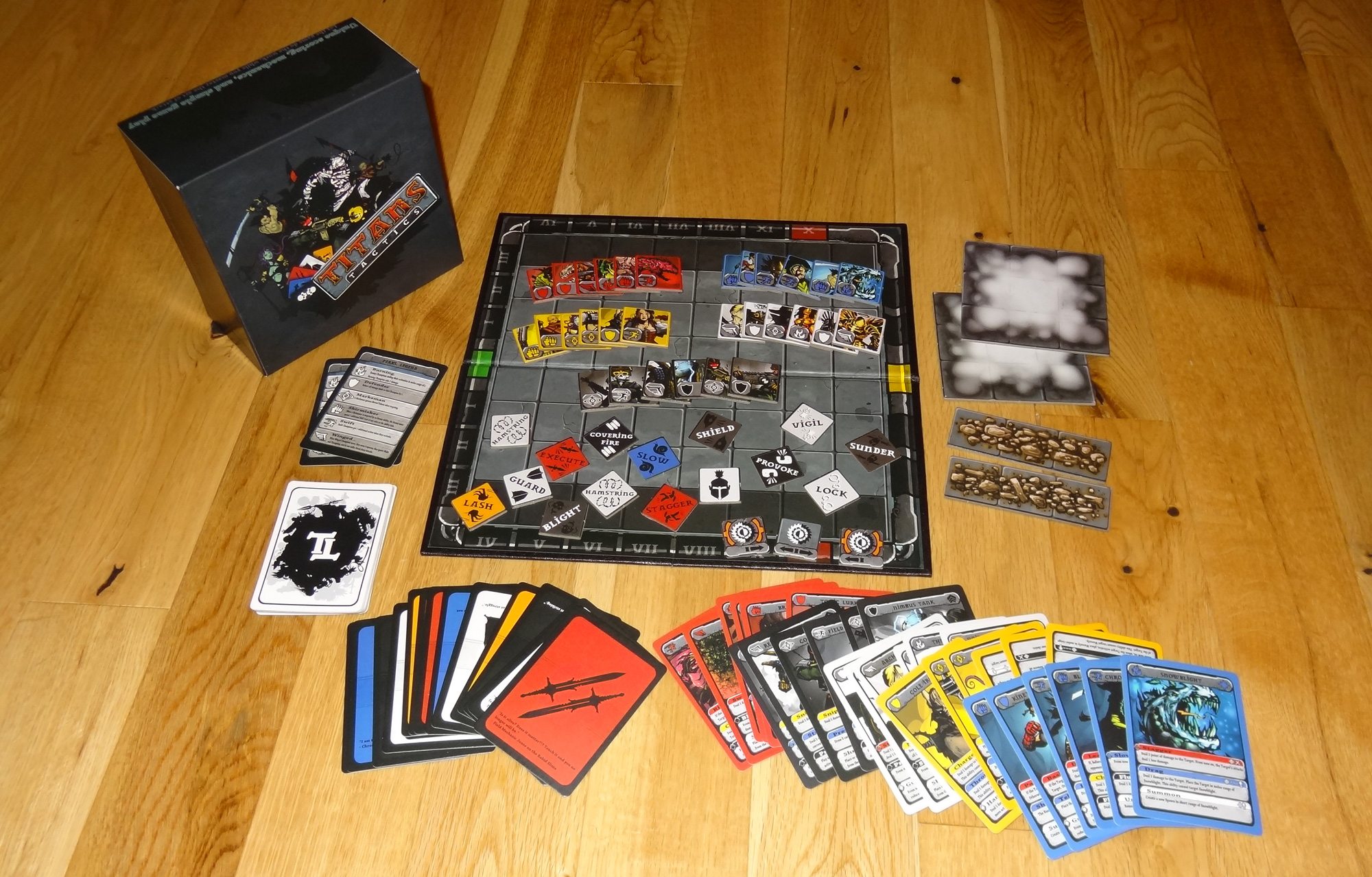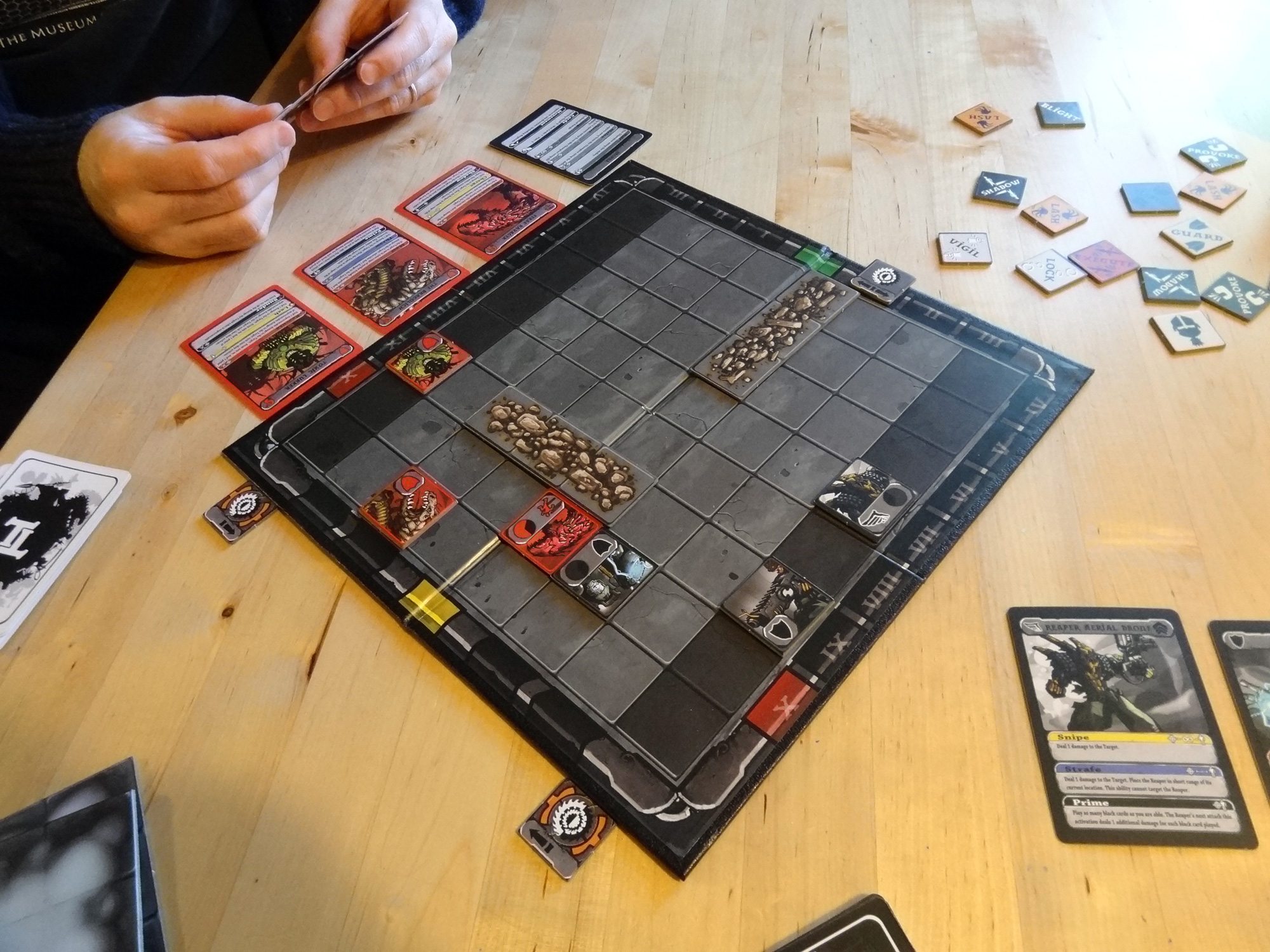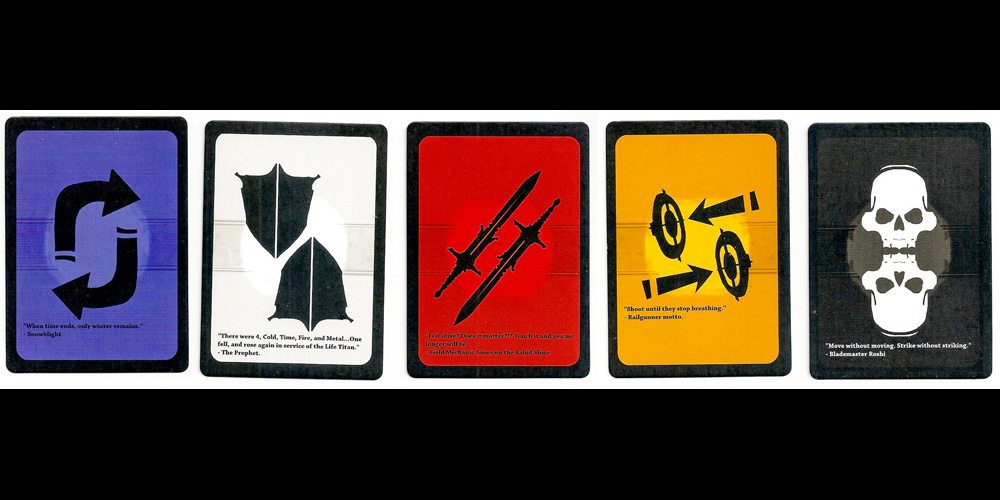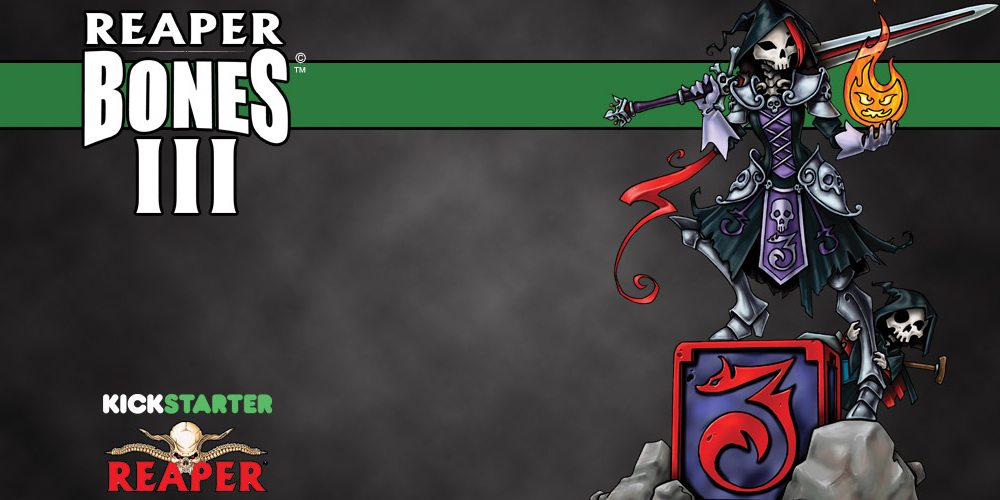Table for Two is a series focusing on two-player board games. Today’s game is Titans Tactics, a tactical battle game between clashing factions.
In Titans Tactics, you and your opponent are Titans, each controlling a faction of Champions in battle against each other. You move your champions around a small arena, trying to shift the balance of power in your favor. It is a purely tactical game—there is no luck involved at all.
At a glance: Titans Tactics is for 2 players, ages 13 and up, and takes about half an hour to play. The age recommendation is probably about right—younger kids who are familiar with tactical games (think Chess) might be able to play it, but it’s fairly involved and also includes things like busty women, skeletons with guns, and blood-spattered … whatever that is. It’s available on Amazon for $24.95.

Components
Here’s what’s included:
- 30 Champion cards
- 30 Champion tokens
- 30 Skill cards
- 2 Reference cards
- 12 double-sided status tokens
- 1 Balance token
- 2 Momentum tokens
- 2 Shroud tokens
- 3 Spawn tokens
- 2 Wall tokens
- 1 game board
All the tokens are cardboard punch-outs, decent thickness and sturdy. The status tokens are all double-sided (with different statuses on each side) but that means it can be hard to find the specific one you’re looking for. The board is a small quad-fold, and the entire game is fairly compact, although the box is sort of bizarre. It’s extra tall for no reason that I can think of, and they didn’t even use the real estate on the side of the box to put the game’s title. Not that it’s a big box, but the game could have been in a flatter box with plenty of room.

The cards themselves are okay—mine were all curved slightly, but in this game you actually don’t shuffle at all so they’re fine. The artwork isn’t my favorite; it doesn’t detract from the game too much but I could do without all the cleavage and the creatures with multiple mouths. Reminds me a little bit of Ascension, though the style isn’t the same. My main complaint about the cards is that the text on the Champion cards explaining each one’s abilities is very tiny. I suppose it’s so there’s more room for the artwork, but I maybe a different font and layout could have made this easier to read.
Because the Champion tokens are fairly small and you can have multiple effects on one of them, it can be hard to arrange them so that you can see all of them. That also can make it a pain to flip over the Champion token (to indicate that it has already acted this round). I decided to turn the Champion cards 90 degrees instead to indicate that it had been activated.

How to Play
To win Titans Tactics, you either need to move the balance token all the way to your end square, or you need to gain three Momentum—I’ll explain more as we go.
Each player selects a faction, and then chooses three of the six champions to use. (The rules have suggestions for your first game to limit the number of abilities you’ll need to learn.) The balance token starts in the middle of the track on the edge of the board, where the green rectangle is. Each player also has a momentum token that starts near their corner of the board—as you earn momentum, you’ll move your token toward the yellow rectangle.
Each player places one of the wall tokens anywhere on the board except in the home rows, the two darker gray rows on the outside edges. One of the interesting things about this game is that walls block movement but not attacks—if you have a ranged attack then it doesn’t matter where the wall is. Then both players place their three Champion tokens in their own home row.

Finally, everyone takes a deck of skill cards (the colored cards), and chooses any five cards to make up their starting hand. It’s worth noting that in this game you never draw cards at random—you always get to choose which cards you want to take from your deck.
During each round, all six of the Champions will act once—when you’ve activated a Champion you flip over the tile so that you can tell it’s been used. When you activate a Champion, you get up to 2 actions, which you may spend on moving or using abilities. (You may spend both actions on the same type of action.) One move action lets you move up to 2 spaces in any direction, though not through walls or other Champions. Each Champion has three abilities (shown on their card), with three different colors. To use an ability, you spend cards of the correct color and then do what the card says. Each ability states who it can target—yourself, a friendly Champion, somebody within melee range (adjacent to you), short range (up to 3 squares away), or long range (anywhere on the board). Some abilities require you to spend all of your cards of a particular color, but then allow you to do more damage.
After you take your two actions, you may then Push or Plan. Push means you get a third action (move or use ability). Plan means you can take 3 skill cards from your deck. Note that you don’t draw back up normally, so you have to decide between taking an extra action or getting more cards in your hand. If you Push and end up with very few cards, then you won’t have access to many abilities during your next turn.
Every time you damage your opponent, you pull the balance token toward you—if it ever reaches the tenth space (the red one), then you win immediately. At the end of the round, the player who currently has the balance token on their side gets a momentum point—you can also win by getting three momentum points.
Each Champion has a perk as well—some reduce all damage by 1, some get additional actions each turn, some can move through walls, and so on. There are some other details, too, like taking damage when you step away from an enemy that’s adjacent to you. There are also some abilities that put status effects on Champions—some are beneficial and some are harmful. There are tokens representing these, and at the end of the round if you want the status effect to continue to the next round, you must pay a card for each effect you want to sustain. Of course, that means you’ll have fewer cards at the beginning of the next round.
But that’s the basic gist of the game. Use your abilities to damage your opponent as much as you can, and keep that balance token on your side as much as possible, like a game of tug-of-war.

The Verdict
Titans Tactics is a curious game—some parts seem familiar, like moving around a board with various characters, each with their own set of abilities. But other parts are new to me, like getting to pick cards out of your deck rather than drawing them at random. But that ends up being a brilliant part of the game, because now it’s a game that is purely tactical and doesn’t involve any luck. There’s still hidden information—you don’t know what cards your opponent is holding—but everything you do has to be planned out, and the game is more about out-thinking your opponent, not just getting a lucky draw.
There are only so many different types of actions, but the various factions have Champions with different combinations of actions, with each faction having certain strengths or tendencies. But even the choice of Champions at the very beginning is important. If you choose three that share a lot of the same color actions, there are advantages and disadvantages. On the one hand, it means your limited hand size can carry more of just the colors you need. On the other hand, it means you’ll have to take the “Plan” action a lot more because you’ll rarely have extra cards left after your turns.
The Push or Plan choice is also a fantastic element—you have to decide between taking extra actions (potentially doing more damage to your opponent or getting yourself in a better position for your next turn) and getting more cards. I like the fact that you don’t automatically draw back up at the end of your turn. It’s very cool when you’re able to do massive damage with a well-planned turn … as long as you’ve got a plan for the next turn when you have no cards left in your hand.
There are some abilities that let you spend multiple cards of a single color. Prime, for instance, uses all of the black cards in your hand and doesn’t do any damage by itself. However, it adds one additional damage per black card to the next attack you do. It’s a powerful ability, but (again) requires that you’ve prepared your hand with lots of black cards and at least one other card for the attack.
Other abilities let you move yourself or opponents around, attack multiple opponents at once, and so on. The status effects are pretty interesting, too—some disable your “move” actions, or make your attacks weaker. “Covering Fire” is one that you play on your own Champions: it means that whenever an opponent moves into melee range of the Champion being covered, the opponent takes two damage immediately. The tricky thing about status effects, though, is that it’ll cost you a card at the end of the round to keep it in play again. So unless you’re prepared to pay that ongoing cost, sometimes it’s not worth using an action to play them in the first place.
The game does have a lot to keep track of—nine abilities across your three Champions, plus status effects on them, plus your Champions’ perks. It’s easy to forget things here and there until you get used to the game. However, once you get the hang of it, Titans Tactics can be very rewarding, and the number of factions and Champions means that there’s a huge amount of variety and replayability. I’ve tried a couple of the different factions, but I could see that each time you play, you’ll have to adjust your strategy according to the particular Champions involved.
The theme is a little odd: you’re somehow doing damage to Champions, but all damage is shared on one track anyway, and nobody ever dies. Somehow damaging the Champions “chips away at their Titan’s power,” whatever that means. But this is especially odd when you consider that the Black Brigade faction’s story says that “no Titan commands this legion.” So when you damage the Black Brigade Champions, who exactly are you hurting? It’s kind of weird.
Still, despite the thematic weirdness and the strange box size and the not-my-favorite art style, I’m a fan of Titans Tactics. It has enough new mechanics mixed in with the familiar that it does feel unlike most tactical games I’ve played, and it’s one that I don’t think I’ll get bored with for a long time. I’d recommend it if you’ve got a gaming partner who’s a match for you strategically, because it’s definitely a game that rewards skill and planning versus luck.
If you’re playing this against your kids, you may want to work out some handicaps to level the playing field, or talk them through their turns—but I think it would be great for getting them to think about how to plan ahead. The nice thing is that in general you’re not planning 5 or 10 moves in advance—but you do need to look ahead each time you choose between Push or Plan, so you know what cards you’re going to need for your next Champion or to sustain status effects.
For more information, visit the Titans Tactics website, or order it from Amazon.
Disclosure: GeekDad received a review copy of this game.






I had a chance to try this at my local game store on Saturday and I really enjoyed it. Having no random draw (and no “discard” pile! Spent cards return to the deck) really makes the game feel personal – If I lose, I can only blame me. Figuring out the layers of complexity (for example, the value of abilities that let you draw _before_ the plan phase) was very satisfying. Easily recommended.
Thanks for this series. I’m always looking for games to play with my son. I’d love to see a review of a game that would work for 8 years and up.
Hi, Kayvaan! I should have a post about BraveRats pretty soon—I believe it was just released officially at Toy Fair this month. That’s a good 2-player game that will work for an 8 year old. A couple others that are in the queue that might be suitable: CubeQuest and Dragon Face (an older one).